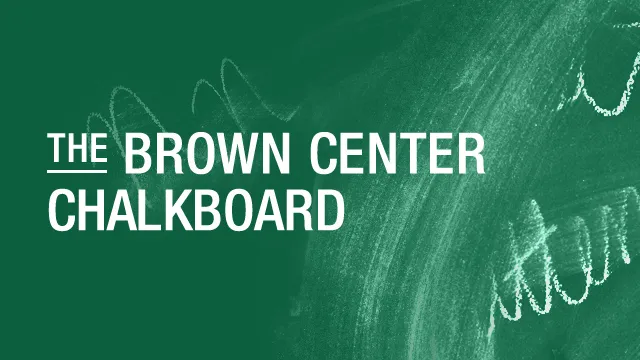

Marshall (Mike) Smith Marshall (Mike) S. Smith is a senior fellow at the Carnegie Foundation for the Advancement of Teaching and previously served as the Under Secretary of the U.S. Department of Education.
December 15, 2016



Economists estimate that by 2020 more than two-thirds of jobs in the United States will require some form of postsecondary education or training. However, at the current rate of higher education completion, the nation will fall nearly 20 million degrees short of meeting that need. According to The Pell Institute, in 2014 only 35 percent of 25-34 year olds had a bachelor’s degree or higher, placing the United States around the middle of 43 developed nations.
Achieving economic competitiveness demands a national response to increase the number of people earning four-year degrees or credentials. Moreover, the degree attainment rate masks pernicious inequities. According to the Pell Institute, more than half of all 24-year-olds with bachelor’s degrees are from families in the top 25 percent of the income bracket, while individuals from the bottom quarter accounted for only 10 percent of four-year degrees.
Moreover, according to the Digest of Educational Statistics, Asians (57 percent) and whites (40 percent) are roughly twice as likely to hold a bachelor’s degree as African Americans (27 percent) and Hispanics (20 percent). Despite recent improvements in college-going rates, the overall degree completion rates, combined with disparities in educational attainment for low-income and underrepresented populations, will impede our nation’s efforts to develop a flourishing, inclusive economy.
The “leaky student pipeline” metaphor, which characterizes the transition points in our educational system where students are lost, provides a powerful framing for identifying how to increase graduation rates. At each transition, some students fall by the wayside, especially black and Hispanic students and those from low-income families. While every transition point is important from a policy and practice perspective, improving student success at three critical junctures would have the greatest impact: (1) high school graduation, (2) pre-college remediation, and (3) college graduation.
The U.S. has made progress over the last 15 years in improving on-time high school completion. A recent GradNation report describes how high school graduation rates began to rise in 2002, after flat-lining for 30 years, and have climbed sharply since 2006. The national graduation rate reached 82.3 percent in 2014—a gain of more than 10 percentage points since 2002. Gains by black and Hispanic students have been the key drivers with both of these student subgroups exceeding the national rate of improvement between 2013 and 2014 (0.9 points), and with yearly gains averaging more than 1.3 percentage points since 2011.
Even with these gains, however, there is much to do to reach GradNation’s goal of having 90 percent of students graduate on time by 2020.
The opportunity gap remains one ongoing challenge. The overall increase in high school graduation rates notwithstanding, substantial racial and economic variation persist. For example, while 88 percent of white students graduate, only 73 percent of African American and 75 percent of Hispanic Americans leave school with a diploma. That means one-quarter of African and Hispanic American students have little chance of obtaining a reasonably well paying job and are effectively shut out of college. [1]
Additionally, the upturn in graduation rates is being criticized by some scholars who argue the higher numbers are the result of districts reducing graduation standards as a way of responding to pressure from the accountability regulations in No Child Left Behind. Critics also point to the use of “credit recovery” courses as examples of scaling down rigor and argue, therefore, that the gains are not real. If this is the case, more students who go on to college will face a second hurdle in the pipeline. At a minimum, there is more work to do at the high school level.
Any action plan to improve high school graduation rates must be coupled with preparing students for success in college-level, credit-bearing English and math courses that are required to earn a degree or certificate. Although some high schools are working harder to prepare their students, many high school graduates cannot pass college readiness tests in these subjects. They are directed to “developmental” (or “remedial”) courses that do not count for college credit.
According to Columbia University’s Community College Research Center (CCRC), 92 percent of two-year colleges and many four-year colleges use reading, writing, and math placement assessments. The State Higher Education Executive Officers Association (SHEEO) and Complete College America report that for two-year colleges, “more than 70 percent of black students and 60 percent of Hispanic students fail the assessments and enroll in at least one remedial course compared to just over 50 percent of white and Asian students.” Another CCRC report finds that 68 percent of community college students and 40 percent of open-access four-year college students are placed into remedial courses.
The critical takeaway is that developmental (remedial) courses do not work, are costly, and disproportionately harm black, Hispanic and low-income students. For example:
These ineffective courses are, in fact, a gatekeeper rather than a gateway for thousands and thousands of students—and particularly for low-income, black, and Hispanic students seeking a college education.
College completion is the third challenge in the leaky pipeline. Data from the Digest of Educational Statistics (Table 1) show that from 2004 to 2014 graduation rates dropped slightly in two-year institutions (from 30.5 percent to 29.4 percent) but increased in four-year institutions (from 55.4 percent to 59.6 percent). Rates increased in both types of institutions for Hispanic students during this period but were more mixed for black and white students. Nevertheless, rates for all students remain dismal at under 30 percent for two-year institutions and under 60 percent for four-year institutions.
Table 1: Two-year and four-year college graduation rates by race/ethnicity
| Two-year institutions | 2004 (2000 cohort) | 2014 (2010 cohort) | Change |
|---|---|---|---|
| All students | 30.5% | 29.4% | -1.1% |
| White | 31.5% | 29.4% | -2.1% |
| Black | 26.1% | 23.7% | -2.4% |
| Hispanic | 30.1% | 33.8% | 3.7% |
| Four-year institutions | 2002 (1996 cohort) | 2014 (2008 cohort) | Change |
| All students | 55.4% | 59.6% | 4.2% |
| White | 58.1% | 63.2% | 5.1% |
| Black | 38.9% | 40.9% | 2.0% |
| Hispanic | 45.7% | 53.5% | 7.8% |
Source: Digest of Education Statistics (2014), Tables 326.10 and 326.20
An EdTrust report noted variation in college graduation rates and trends between public and private institutions. Although, in 2013, six-year graduation rates were higher in private nonprofit institutions (65.3 percent) than public institutions (57.7 percent), those rates were climbing more quickly in public institutions.
The exciting story is that we know how to substantially plug the leaky pipeline to increase secondary school graduation rates, improve outcomes in developmental courses, and boost college graduation rates. Moreover, we have robust examples of successful interventions at each of the three links in the pipeline.
A recent report on college completion from EdTrust makes the argument that undergirds improvement in each of the three areas: “By now, college leaders understand that just adding an initiative or two—a First-Year Experience, a few learning communities or freshman seminars, a new tutoring or multicultural center—typically won’t be sufficient… no single strategy works everywhere. But at the core of all of their strategies is a very different use of institutional data. No longer just the stuff of institutional reports to various government agencies, data is used throughout institutions to mobilize action.”
The critical message? Use institutional data to mobilize effective, comprehensive, coherent, and continuous improvement.
A successful policy should build these capacities and capabilities:
The continuous improvement approach to address complex problems is not new and has been championed by organizations like EdTrust, Data Quality Campaign, and SHEEO. Below, we provide examples for each part of the pipeline.
Fresno Unified School District (FUSD), where more than 60 percent of the students are Latino and nearly three-quarters are eligible for free and reduced priced lunch, turned in 2010 to an innovative use of data systems to make sure that students stay on track for graduation. The data systems track key indicators in real time, such as student performance in classes, whether students signing up for the courses they need to graduate, and whether counselors have a manageable load. When the data system raises “on-time” alarms, staff (counselors and others) contact students and work collaboratively to address the issues. By 2016, FUSD’s graduation rate rose from less than 70 percent to 84 percent—more than double national and California’s gains and to a level exceeding the nation and California. Moreover Fresno also focused on increasing enrollment in courses required for admission to California State University and the University of California (known as A-G courses). The rate almost doubled from 25 percent to 49 percent over the past six years.
Of course, improving high school performance is only the first step. In recent years, several groups used improvement processes to redesign developmental courses, making them far more effective and efficient than traditional remedial courses. These include the Accelerated Learning Program, California Acceleration Project, Complete College America, and New Mathways Project. Participants in another project, the Carnegie Math Pathways, were 40 percentage points more likely to pass remedial math than comparison groups. A return on investment study conducted by the National Center for Inquiry and Improvement found that Pathways’ upfront costs are often less than boutique programs that serve fewer students and are not as scalable.
Georgia State University (GSU) and Florida State University (FSU) provide examples of success in increasing college graduation rates. The institutions accelerated capacity by using data and predictive analytic services of the Education Advisory Board (EAB) and by participating in EAB’s student success collaborative, an improvement network. These improvement practices are well described by EdTrust. Over a 12-year period, graduation rates increased at these institutions by 16-18 percentage points overall—and even more for minority students.
All of these examples can be replicated. The gains are due to hard work, staff commitment, smart use of data, and a strategy of continuous improvement. There are no good excuses for high schools and colleges to not deliberately address these national problems.
Each of the three interventions described in this memo—improving high school graduation rates, addressing remediation, and improving college graduation rates—could operate independently. Working separately on each pipeline barrier would increase the number and diversity of college graduates. However, in order to vastly accelerate the graduation rates while reducing disparities for low-income and minority populations, all three parts of the leaky pipeline demand policy support via an integrated effort. The value would be even greater if regions of states formed alliances among K-12 and postsecondary institutions to address, together, the needs of the students at all three stages. This form of collective effort in networked improvement communities would have powerful impacts in reducing educational inequities.
Our proposed way forward focuses on the need of the federal government to help districts, institutions, and states take these improvements to scale. We suggest four areas for federal policy and support.
They can do this by setting clear national goals and encouraging states to set their own challenging goals. Policymakers and educators need to consider college success as a part of a continuum that begins in high school, because the classes students take and improvements in high school graduation rates directly influence what happens in college.
Following on the successes of GSU and FSU and other colleges, the title would authorize resources for new real-time data improvement systems and for preparing counselors and others to implement the data systems. The new legislation would also provide resources for regional colleges and NGOs to provide support for all colleges to improve their developmental (remedial) courses. Finally, the title would provide support for improvement networks of colleges to share information and assist each other in the development and implementation of the two strategies.
They should encourage states to do the same. They should work with existing coalitions of organizations that have similar goals and should make certain that any existing regulations or practices of the federal government do not inhibit the progress of schools, districts, and states to meet these goals.
In addition, the Department should make it clear that various provisions in ESSA could support schools and districts as they put together the new early warning data systems and support their counselors and teachers as they learn to use the systems to help students.
One example here is Fresno, where schools improved in both the graduation and college-required A-G course rates simultaneously. We need examples of other districts that have successfully adopted similar systems and achieved similar results. (See also the Harris memo on the federal role in research.)
Taken together, the successful implementation of these interventions would create a tremendous boost in college attainment overall and in reducing graduation inequalities based on income, race, and ethnicity. Over time, this approach would substantially help the country’s economic competitiveness. Each of the three examples provides a strong model of how to meet retention, attainment, and equity goals. These and similar examples have been locally driven without direct federal and state governments involvement. But, as we noted, federal support is crucial in scaling these proven interventions. The president’s and secretary’s support of continuous improvement infrastructure, including useful data systems along with improvement networks engaged in rapidly testing, adapting, and integrating evidence-based interventions, would provide important intellectual and practical support across the nation. Federal attention and involvement is integral to solving the national challenge of helping to create a well-educated, diverse workforce.
[1] These rates are for on-time graduation using the new measure required by the federal government. Some students not counted may graduate after six years and others have taken the GED. Combining these various alternatives brings the estimated current rates to near 90 percent. This leaves a little over 10 percent of students entering the economy every year without any claim to graduating. The income and ethnicity gaps continue to exist.
Support for this project was generously provided by the Spencer Foundation. Brookings recognizes that the value it provides is in its absolute commitment to quality, independence, and impact. Activities supported by its donors and by outside contributors reflect this commitment. The authors did not report receipt of financial support from any firm or person for this memorandum or from any firm or person with a financial or political interest in this article that creates a conflict of interest.
Smith, M. S., & Parmley, K. (2016). Improving and equalizing high school and college graduation rates for all students. In M. Hansen & J. Valant (Eds.), Memos to the President on the Future of U.S. Education Policy. Washington, DC: Brookings Institution.